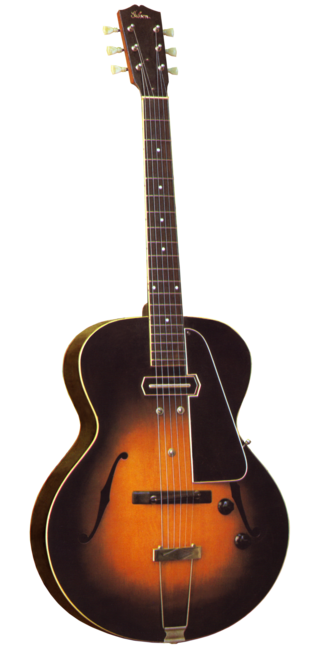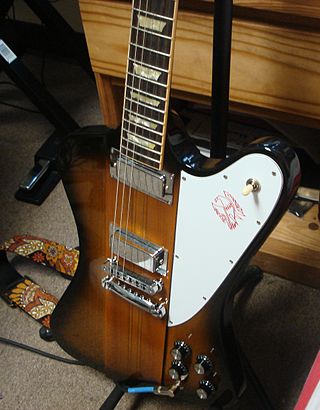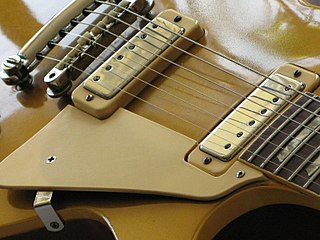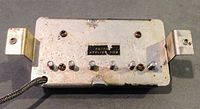
A humbucker, humbucking pickup, or double coil, is a guitar pickup that uses two wire coils to cancel out noisy interference from coil pickups. Humbucking coils are also used in dynamic microphones to cancel electromagnetic hum. Humbuckers are one of two main types of guitar pickups. The other is called a single coil.

The Gibson ES-150 is a pioneering electric guitar produced by Gibson Guitar Corporation. Introduced in 1936, it is generally recognized as the world's first commercially successful Spanish-style electric guitar. The ES stands for Electric Spanish, and Gibson designated it "150" because they priced it at around $150. The particular sound of the instrument came from a combination of the specific bar-style pickup and its placement, and the guitar's overall construction.

The Gibson Les Paul is a solid body electric guitar that was first sold by the Gibson Guitar Corporation in 1952. The guitar was designed by factory manager John Huis and his team with input from and endorsement by guitarist Les Paul. Its typical design features a solid mahogany body with a carved maple top and a single cutaway, a mahogany set-in neck with a rosewood fretboard, two pickups with independent volume and tone controls, and a stoptail bridge, although variants exist.

A single-coil pickup is a type of magnetic transducer, or pickup, for the electric guitar and the electric bass. It electromagnetically converts the vibration of the strings to an electric signal. Single-coil pickups are one of the two most popular designs, along with dual-coil or "humbucking" pickups.
Seth E. Lover was a designer of amplifiers and musical instrument electronics and effects. He is most famous for developing the Gibson humbucker or hum-cancelling electric stringed instrument pickup, most often used on the electric guitar.

A pickup is an electronic device that converts energy from one form to another that captures or senses mechanical vibrations produced by musical instruments, particularly stringed instruments such as the electric guitar, and converts these to an electrical signal that is amplified using an instrument amplifier to produce musical sounds through a loudspeaker in a speaker enclosure. The signal from a pickup can also be recorded directly.

The Gibson Firebird is a solid-body electric guitar manufactured by Gibson beginning in 1963.

The Fender Telecaster Deluxe is a solid-body electric guitar originally produced from 1972 to 1981, and re-issued by Fender multiple times starting in 2004.

The P-90 is a single coil electric guitar pickup produced by Gibson Guitar Corporation since 1946, as well as other vendors. Compared to other single coil designs, such as the Fender single coil, the bobbin for a P-90 is wider but shorter. The Fender style single coil is wound in a taller bobbin, but the wires are closer to the individual poles. This makes the P-90 produce a somewhat warmer tone with less edge and brightness, As with other single-coil pickups, the P-90 is subject to AC hum unless some form of cancellation is used.

DiMarzio, Inc. is an American manufacturing company best known for popularizing direct-replacement guitar pickups. The company also produces other accessories, such as hardware, guitar straps, and instrument cables.

The Fender Wide Range Humbucker is a humbucker guitar pickup, designed by Seth Lover for Fender in the early 1970s. This pickup was intended to break Fender's image as a "single coil guitar company," and to gain a foothold in the humbucker guitar market dominated by Gibson.

Fender Telecaster Custom is a model of electric guitar made by Fender.

The mini-humbucker is a humbucking guitar pickup. It was originally created by the Epiphone company. The mini-humbucker resembles a Gibson PAF humbucker, but is narrower in size and senses a shorter length of string vibration. This produces clearer, brighter tones that are quite unlike typical Gibson sounds. It fits in between single-coils and full-sized humbuckers in the tonal spectrum. It is frequently used in jazz guitars, mounted under the fingerboard or on the pickguard.

The Gibson L6-S is a solid body electric guitar. It was the descendant of the L5S jazz solid-body electric guitar. It was the same shape, very much like a wide Gibson Les Paul, but with a 24-fret neck, the first Gibson guitar to have this.
The Gibson Les Paul Custom is a higher-end variation of the Gibson Les Paul guitar. It was developed in 1953 after Gibson had introduced the Les Paul model in 1952.

The Gibson Nighthawk was a family of electric guitars manufactured by Gibson. Introduced in 1993, the Nighthawk represented a radical change from traditional Gibson designs. While its maple-capped mahogany body and set neck were reminiscent of the classic Gibson Les Paul, the Nighthawk incorporated a number of characteristics more commonly associated with Fender guitars. The Nighthawk was not a commercial success; production of all models was discontinued in 1998 after only five years.
Electric guitar design is a type of industrial design where the looks and efficiency of the shape as well as the acoustical aspects of the guitar are important factors. In the past many guitars have been designed with various odd shapes as well as very practical and convenient solutions to improve the usability of the object.

The Fender Noiseless series is a line of electric guitar pickups made by the Fender Musical Instruments Corporation designed to cancel 60 cycle (Hz) hum noise while retaining the characteristic sound of single coil pickups. Introduced in 1998, these pickups consist of a pair of single coils stacked one on top of the other, compacted so as to match the shape and width space as a traditional Fender single coil guitar pickup, while being only slightly taller. The upper coil is actually the sound source, while the lower coil is responsible for the mains hum attenuation. Alnico 5 magnetic bars span from one coil to the other, crossing a soft ferrous steel spacer plate that isolates them, without touching it. The spacer plate has mainly two functions: to isolate the lower coil from the vibrations of the string, making sure that the sound is picked up only from the upper one, and to increase the magnetic flux that passed through both coils, increasing the output of the pickup. This is to be contrasted with the original noise canceling pickup, the humbucker, which is a double-wide, horizontally adjacent pair of single coil pickups with opposing phase.
The Fender Telecaster, colloquially known as the tele, is an electric guitar produced by Fender. Together with its sister model the Esquire, it was the world's first mass-produced, commercially successful solid-body electric guitar. Its simple yet effective design and revolutionary sound broke ground and set trends in electric guitar manufacturing and popular music. Many prominent rock musicians have been associated with the Telecaster for use in studio recording and live performances, most notably Bruce Springsteen, Prince, Luis Alberto Spinetta and Keith Richards.

The Filter'Tron is an early model of the humbucker guitar pickup invented by Ray Butts in the 1950s. Butts built the prototype Filter'Tron in 1954 for guitarist Chet Atkins and it was manufactured by Gretsch and installed in almost all of the brand's guitars beginning in 1957. Gretsch guitars and the "growl" and "twang" of their Filter'Trons played a major part in the rise of rock and roll, with adopters like Bo Diddley, Duane Eddy, George Harrison, and Neil Young. After a sharp decline in popularity in the 1970s and early 1980s, the Gretsch brand and Filter'Tron sound experienced a revival when Brian Setzer renewed public interest in the rockabilly genre. Gretsch guitars have since been embraced by new generations of guitarists, especially in rock music, and many manufacturers now offer Filter'Tron-style pickups.




















